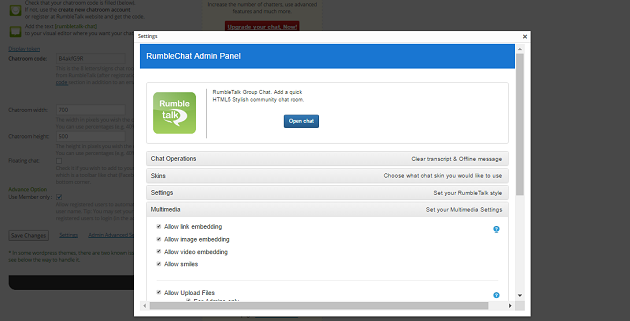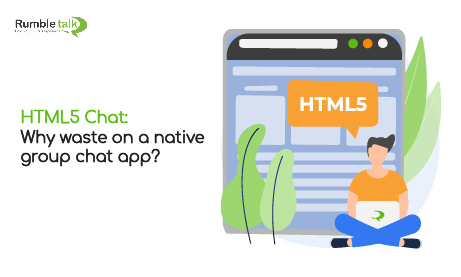Does anyone remember Flash? If a movie featuring human butterflies and a theme song by Queen popped into your head, don’t feel bad — the movie will probably remain relevant to humanity long after Flash player has dissolved into obscurity.
To be honest, I didn’t actually hate Flash player. What I did hate was having to constantly mess with plug-ins and updates every time I loaded an online program. And while it’s still relevant, the reason you probably thought of Sam Jones when I asked about Flash is because the rest of the internet got tired of it as well.
It was a Dodo whose viability was already debatable by the time it met its end at the hands of a hungry sailor called HTML5. But certain elements of the web-based programming community have been surprisingly sluggish in adopting the new markup language.
This is somewhat vexing, and particularly so in the case of online chat communities. For one, the embeddable image, video and audio options native to HTML5 make the language extremely programmer-friendly.
It is also the closest thing out there to a universally compatible web-based markup language, whether between browsers or between web and mobile platforms. Of course, these advantages ultimately funnel through to end users who choose an HTML5 chat platform.
So what’s the holdup?
Well, a lot has happened to online chat in past decades, much of which has surrounded the transition to mobile use. Today, the most popular mode of execution is through use of a native mobile application. Not surprisingly, this trend has led to a massive proliferation of application-based chat and audio-visual communication. Mobile users today carry around numerous chat apps — all downloaded to their devices and all of which accomplish at least marginal variations of practically the same thing. Considering the fact that once upon a time Comic Chat was a revolutionary idea, today’s mobile-app based approach seems like a climax in consumer convenience and options.
But is it, though?
The “mobile site” practice was once the recommended way to go if you wanted to access secure information from a mobile device. Some online banking and other commercial entities still do this, and even Facebook will direct you to a mobile site if you use your phone’s web browser. Thing is, you probably haven’t seen it since you downloaded that “trusty” native app. Use of these mobile sites has gradually faded under the growing cloud of readily downloadable native applications.
This should come as a bit of a surprise, given that it translates to a big waste of potential from an HTML5 perspective.
Don’t get me wrong; mobile apps run fine and are frequently updated to eliminate bugs and optimize performance. But they nevertheless present a host of avoidable issues.
Good example: my own love/hate relationship with Facebook’s iPhone apps. For going on about a week now, I have been unable to (re)download the messenger app after our most recent “get out and never come back!” episode.
Why is this happening to me? Is it me? Is it the phone? Was it something I said? Not a damn clue. And frankly I don’t care. I just want my baby to come back, and nothing I’ve tried has worked.
But you know what does work, right now as I sit and write this blog? Facebook’s mobile site, messages and all, minus the insanity of forcing me to download a separate chat application.
Bit of an extreme example? Maybe, but it underscores a point: why waste time downloading, updating and occasionally tossing your phone in anger across the room over applications that could work just as well if not better on a mobile platform?
The phenomenon of downloadable apps is a bit of an oddity altogether considering the vast amount of space and memory which apps fill and use for functions that a simple web browser can readily accomplish.
Case in point: what really angers me about my little predicament is that you actually need two apps to fully utilize Facebook on an iPhone, of all things.
This is an epic fail on Facebook’s part.
Indeed, “need” is a misnomer because you don’t “need” the app. You just want it enough to think you need it.
Here are two “little things” that make Facebook Messenger so addictive:
• audio-video
• push notifications
You want to know why Facebook’s mobile site doesn’t have these features? Because they didn’t add them — period. Let that sink in for a second. They are fully able to develop a universally device- and browser-compatible HTML5 chat feature on their mobile site, complete with all the embedding features available to you on your laptop or desktop, but they just haven’t done it. For some reason, Facebook wants you to download two separate applications onto potentially the most advanced consolidation device ever invented. And while I have just about had it with my iPhone, it’s not Apple making me hate my life. If there’s one thing that can be said about Apple, its that they take the “everything you need, right here” approach to product design. They don’t always do it perfectly (or well, for that matter), but they do it every time. It’s Facebook’s apps which are screwing me here.
So, why am I making such a big stink over this?
We should be getting tired of downloading, updating, and otherwise pulling hair out of our head over apps that shouldn’t be on your device in the first place. The only reason we still grab items out of cyberspace is because marketers know how to capitalize on our simian instinct to stuff our cheeks full of figs so that the other monkeys can’t have the ones we want.
That world is gone. It’s over. There’s no need for everyone to have their own downloaded program because that same program is still available to everyone regardless of whether someone else is using it. There’s better things we can be doing with our time.
That’s what HTML5 is all about. It is based on an entirely new kind of mindset, used by a new generation of programmers, demanded by a new generation of consumers.
Think about it this way: which of the following would you hope is going through a programmer’s head:
• how can I spend days, weeks or even months reinventing its embedding features when someone has already automated somewhere else?
• How can I spend my time doing new stuff now that the old stuff is already built in?
In this sense, time is money, and money is quality. And its not just about the cost to the developer. It’s also about the user’s time and experience.
Chat Room Easy Settings
Our designers at RumbleTalk understand this all too well and for that reason have chosen an HTML5 as a platform for our web/mobile chat, allowing us optimize its plugin features and compatibility. RumbleTalk’s native features allow our program to run on less complex code, which translates to faster loading and fewer errors, and allows our users unprecedented control over the chat settings.

The native HTML5 chat embedding and compatibility options allow our clients to easily adjust settings. The built-in video/audio playback as well as other plugins allow users to intuitively tailor the online chat experience to the type of hosting they wish to present, whether it’s social stock trading, community engagement, online events, teaching or radio show hosting — all customizable to ensure that the user can create a personalized environment.
Just as importantly, our HTML5 chat platform is web-based, and works as one single program without the complexity and performance issues associated with having to “make” the program’s elements compatible with each other.
Our program, of course, is fully browser cross-compatible with all major web browsers, which in today’s market should be a given. To that point, one of the biggest advantages is the fact that HTML5 chat allows optimal functionality for mobile site access, with compatibility across the board of mobile devices. This means consistently optimized performance from one type of device to another, all without unnecessary downloaded applications. You simply access the full program on your mobile device on virtually any mobile web browser.

Hopefully my gripe about downloaded programs is a little clearer now. There’s really no reason to carry a phone full of applications which can only be used via internet access.
Now, does that mean I am going to uninstall Cookie Jam in silent protest until I can access the game on a website? God, no. In fact, I count on having the game accessible and functional on my device specifically for the times that I don’t have internet.
Likewise with music, videos, pictures and documents. You know, the stuff that has any business taking up space and memory on your device. Everything else should be cloud-based and simple. From the perspective of online chat services, for which consumers will undoubtedly demand more complex and dynamic features, this is what HTML5 is all about.

